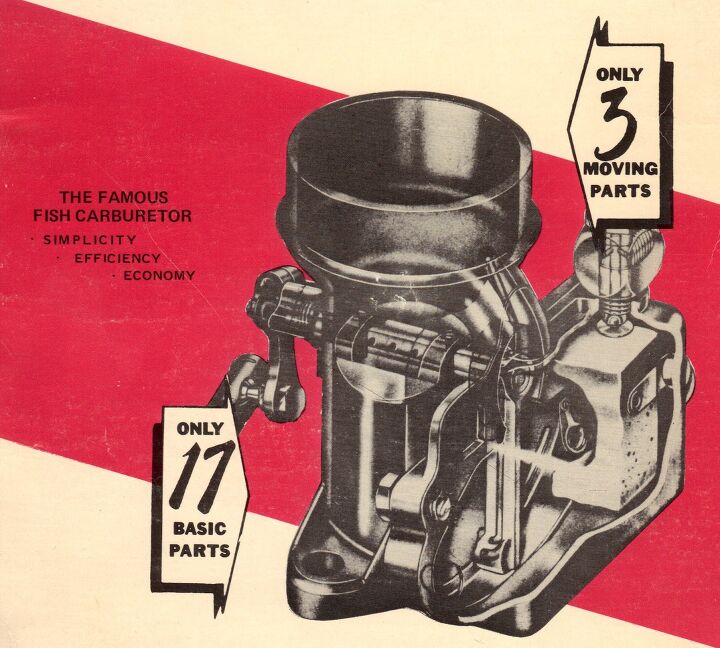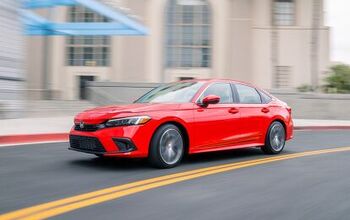Automotive Conspiracy Theories and Urban Legends

Is there something about cars and car companies that make people tend to believe that there are all sorts of conspiracies keeping us from driving the car of all our dreams? I ask the question because I can think of at least a half dozen urban legends, conspiratorial glosses put on actual events, and outright conspiracy fantasies that are or have been popular among car enthusiasts and the general public.
I suppose the grandaddy of them all is the 200 mile per gallon carburetor but there are many others. The EV equivalent to the Fish carb would be Nikola Tesla’s radio wave powered experimental Pierce Arrow. The theorists tell us that were it not for the car companies buying up patents to keep those technologies away from their competitors, we’d have access to those technologies. Somehow the idea that the owners of that intellectual property would exploit it for commercial and competitive purposes seems to be lost on those that believe these tall tales. In some versions, of course, it’s the nefarious oil companies that are suppressing technologies that would threaten their profits.
A related conspiracy theory has to do with John D. Rockefeller and Prohibition. Rockefeller was in the petroleum business, first making a fortune selling kerosene, which was used for lighting. When Edison, Westinghouse, Steinmetz and Tesla made it possible for electricity to be used for power and lighting, Rockefeller, looking for a use for a toxic and almost explosive refinery byproduct he’d been throwing out, started to encourage its use as a fuel, converting the stationary powerplants in his refineries from steam to gasoline and, according to some historical sources, subsidizing the sale of gasoline engines to farmers, who were a primary market for stationary engines, to run farm equipment.
Now the above paragraph is historically reliable, at least to my own satisfaction. However, it took me a while to get the information. You see, when I started to enter [Rockefeller, gasoline engines] into a search engine, the first two pages of results were almost all about how John D. Rockefeller was the head of a conspiracy that led to the United States adopting Prohibition. It seems, according to the conspiracy theories, that Rockefeller put his money behind prohibiting drinking alcohol because he wanted to suppress ethanol as a fuel, which could, theoretically, compete with gasoline.
Another quasi conspiracy theory also involves gasoline and alcohol. It’s related to General Motors’ and DuPont’s development of tetra-ethyl lead as a gasoline additive to prevent pre-ignition knocking and allow the use of more powerful higher compression engines. In the late teens and early 1920s, before the large oil deposits in Saudi Arabia and elsewhere in the Mideast were discovered, there were concerns about running out of petroleum. “Peak oil” is not a new concept. Casting about for alternative fuels GM’s Charles Kettering started looking into gasoline/ethanol blends, which can have reduced octane due to phase separation and the ethanol absorbing water, so they started looking into ways of boosting octane. GM and the DuPont chemical company were joined at the hip for much of the 20th century and a joint research project ended up with the development of leaded gasoline. In the meantime, new petroleum deposits were discovered and tetra-ethyl lead ended up as an octane booster for gasoline. Where the conspiracy theories start is at just how much GM and DuPont suppressed information about the dangers of leaded gas.
So there is some basis in fact for some of the conspiracies, but then the Talmud teaches that no lie can be believable without some grain of fact. Failed EV entrepreneur Ed Ramirez has claimed for decades that his Amectran EXAR-1 was foiled by a conspiracy at the Environmental Protection Agency. I happen to think that Ramirez started believing his own PR, but the idea that a bureaucrat or government agency might kill a promising technology is not that far fetched. When the then young EPA started a program to encourage new clean air technologies, hybrid car pioneer Victor Wouk’s hybrid 1973 Oldsmobile Cutless showed great promise and met all the test criteria that the EPA demanded, but the project was indeed killed by EPA administrator Eric Stork.
Getting back to General Motors, not only did they supposedly conspire to give us all lead poisoning, but the big automaker also allegedly conspired to eliminate environmentally sensitive electric streetcars, so they could make money selling polluting city buses.
Sometimes the conspiracies just percolate in the public mind. Other times they get a boost from Hollywood. Lots of car companies have failed. You don’t need a conspiracy to have the cards stacked against a startup car company. Literally thousands of car companies have gone belly up, and Preston Tucker’s business plan had some big holes in it, so the Tucker company’s failure was no surprise. According to some Tucker faithful, and amplified by Francis Ford Copolla’s film, though, Tucker didn’t fail because he bit off way more than he could chew, with a car that had to be developed on the fly, he failed because the Big 3 got Washington to go after him for securities fraud.
So what automotive conspiracy theories have you heard, and which of them do you believe? Being a Learned Elder of Zion I’m a bit allergic to conspiracy theories and conspiracy theorists in general, but you can try to convince me.
Ronnie Schreiber edits Cars In Depth, a realistic perspective on cars & car culture and the original 3D car site. If you found this post worthwhile, you can get a parallax view at Cars In Depth. If the 3D thing freaks you out, don’t worry, all the photo and video players in use at the site have mono options. Thanks for reading – RJS

Ronnie Schreiber edits Cars In Depth, the original 3D car site.
More by Ronnie Schreiber
Latest Car Reviews
Read moreLatest Product Reviews
Read moreRecent Comments
- Arthur Dailey We have a lease coming due in October and no intention of buying the vehicle when the lease is up.Trying to decide on a replacement vehicle our preferences are the Maverick, Subaru Forester and Mazda CX-5 or CX-30.Unfortunately both the Maverick and Subaru are thin on the ground. Would prefer a Maverick with the hybrid, but the wife has 2 'must haves' those being heated seats and blind spot monitoring. That requires a factory order on the Maverick bringing Canadian price in the mid $40k range, and a delivery time of TBD. For the Subaru it looks like we would have to go up 2 trim levels to get those and that also puts it into the mid $40k range.Therefore are contemplating take another 2 or 3 year lease. Hoping that vehicle supply and prices stabilize and purchasing a hybrid or electric when that lease expires. By then we will both be retired, so that vehicle could be a 'forever car'. Any recommendations would be welcomed.
- Eric Wait! They're moving? Mexico??!!
- GrumpyOldMan All modern road vehicles have tachometers in RPM X 1000. I've often wondered if that is a nanny-state regulation to prevent drivers from confusing it with the speedometer. If so, the Ford retro gauges would appear to be illegal.
- Theflyersfan Matthew...read my mind. Those old Probe digital gauges were the best 80s digital gauges out there! (Maybe the first C4 Corvettes would match it...and then the strange Subaru XT ones - OK, the 80s had some interesting digital clusters!) I understand the "why simulate real gauges instead of installing real ones?" argument and it makes sense. On the other hand, with the total onslaught of driver's aid and information now, these screens make sense as all of that info isn't crammed into a small digital cluster between the speedo and tach. If only automakers found a way to get over the fallen over Monolith stuck on the dash design motif. Ultra low effort there guys. And I would have loved to have seen a retro-Mustang, especially Fox body, have an engine that could rev out to 8,000 rpms! You'd likely be picking out metal fragments from pretty much everywhere all weekend long.
- Analoggrotto What the hell kind of news is this?


































Comments
Join the conversation
@niky - You're getting yourself all confused again. Nowhere does the study TAKE INTO ACCOUNT that men drive 74% more. Or show me where it does. And that's exactly where it's flawed. Men do drive 74% more within the study, but no adjustment is made for it. I mean to equalize the per person miles or for an equal commute comparison. The TOTAL miles driven is EQUAL FOR BOTH GROUPS in the study, but here's the clincher... You ready? Here goes... Miles driven are NOT EQUAL PER PERSON in the study. See the subtle difference there? Every female in the study crashed an average of 5.7 times, BUT there just happens to be more women in the study to make up the more miles driven per male in smaller group of men. You're right about men dying at a much higher rate and I've never disputed that. Men take more chances which is true. However, there is zero data on the speeds at time of impact. Obviously, speed kills. The chances of dying increase exponentially with higher speeds. So it's clear women crash slower speed, but accidents are accidents. Mortality rates increase as speeds increase, and this points back to the 74% great distance covered by men. I know all of it can't be blamed on the more miles traveled, but if you have 2 miles to cover, you may stay on a surface street, but at 3.5 miles to cover, a you're more likely to jump on the freeway. Men may be less likely to wear a seat belt and many states don't require helmets of motorcyclists which are mostly male. Again, I'm not disputing men are a bigger risk to themselves and insurance companies, but that was my original statement: "Women are safer risks because they drive far less miles". "13 Reasons Why Women Are Better Drivers" I don't know how scientific this study was, but it's definitely pandering. #1 "Men Feel Like They Own The Road" Yes we already knew men are more aggressive, but mostly young males. Young males throw off the curve for the rest of the male age groups it seems. #2 "Women Have Fewer Accidents" I don't know who "Quality Planning" is, but I know I'd find the same type of study that's doesn't account for women driving far less miles. Irrelevant. #3 "Scantily Clad Women" They're a distraction for me too, but these under dressed women are running interference for the study, it seems. The article goes downhill quick after this so I won't embarrass you further. It goes from 'no duh' to 'pointless' to 'what does THAT have to do with anything?' #10 "Danica Patrick"??? It's just another biased article that's headlines grabbing and draws clicks. Of course it doesn't mention that men drive that much more miles or that women drive much worse than men and crash at much higher rate than men from 35 years of age and older. Not surprisingly, the article did make sure to mention the bad driving of young males.
@Niky Go to Pickuptrucks.com under News and look at the past 6 weeks and you will see what lengths he goes during debates. Look at my name and you will notice something funny. I post under one name. You will be surprised. As not all of the posts are mine. He states information as facts, then states it an opinion. He's a weirdo.